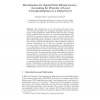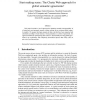AIME
2011
Springer
13 years 5 months ago
2011
Springer
Representing the Foundational Model of Anatomy (FMA) in OWL 2 is essential for semantic interoperability. The paper describes the method and tool used to formalize the FMA in OWL 2...
SEMWEB
2010
Springer
2010
Springer
Theoretical foundations and engineering tools for building ontologies as reference conceptual models
14 years 17 days ago
Abstract. Perhaps the most fundamental notion underlying the desiderata for a successful Semantic Web is Semantic Interoperability. In this context, ontologies have been more and m...
DEBU
2002
14 years 5 months ago
2002
Ontologies are set to play a key role in the "Semantic Web", extending syntactic interoperability to semantic interoperability by providing a source of shared and precis...
JODS
2006
14 years 5 months ago
2006
Abstract. We study the exchange of information in collective information systems mediated by information agents, focusing specifically on the problem of semantic interoperability. ...
JODS
2006
14 years 5 months ago
2006
We introduce a novel view on how to deal with the problems of semantic interoperability in distributed systems. This view is based on the concept of emergent semantics, which sees ...
GISCIENCE
2010
Springer
14 years 6 months ago
2010
Springer
The categorization of our environment into feature types is an essential prerequisite for cartography, geographic information retrieval, routing applications, spatial decision supp...
MMGPS
2003
14 years 7 months ago
2003
This paper describes a novel approach for obtaining semantic interoperability in a bottom-up, semi-automatic manner without relying on pre-existing, global semantic models. We ass...
CORIA
2008
14 years 7 months ago
2008
Semantic interoperability between heterogeneous sources of information is significant problems because of the number growing of sources of information available on the Web. The use...
ATAL
2008
Springer
14 years 7 months ago
2008
Springer
In order to obtain semantic interoperability in open MultiAgent Systems, agents need to agree on the basis of different ontologies. In this paper we formally define mapping as cor...
ER
2006
Springer
14 years 9 months ago
2006
Springer
Ontologies on the Semantic Web are by nature decentralized. From the body of ontology mapping approaches, we can draw a conclusion that an effective approach to automate ontology m...







